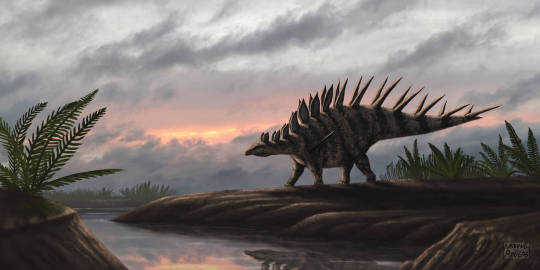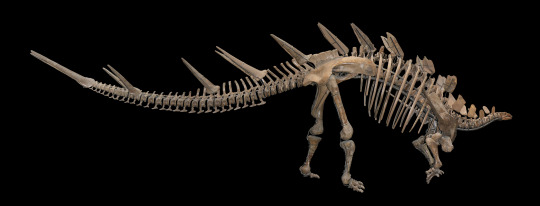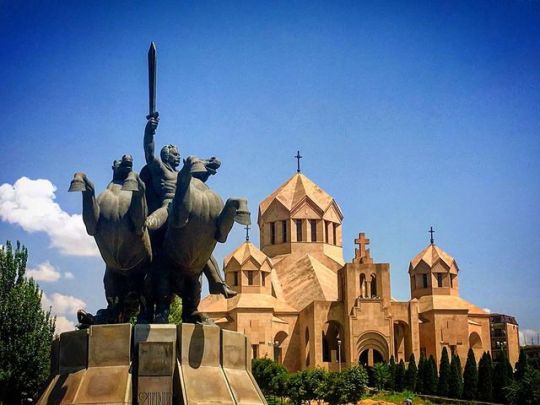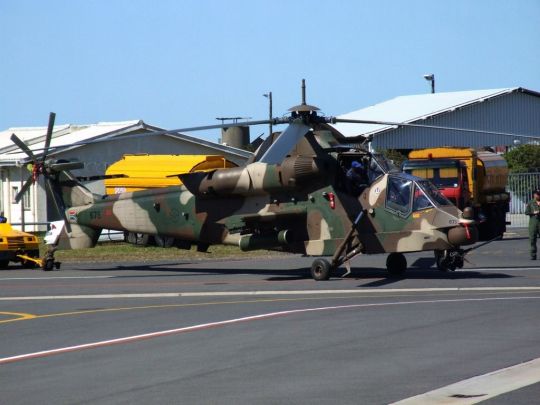#kentron
Note
hello ! Im going to yerevan soon, what are some good libraries/book shops in kentron ?
Hi! It's so nice to hear that! Have you been to Armenia before? 🧡
Here are some addresses that might be of use to you:
Bookinist, 20 Mesrop Mashtots Ave
Zangak Bookstore, 7 Abovyan St
a book market of sorts, 15 Moskovyan Street
9 notes
·
View notes
Text










Kentrosaurus is a genus of stegosaurid dinosaur which lived throughout what is now Africa during the Kimmeridgian and Tithonian ages of the Jurassic period some 154 to 145 mya. The first fossils of Kentrosaurus consisting of the partial remains of over 50 individuals were discovered by the German Tendaguru Expedition in 1909. These remains were described by German palaeontologist Edwin Hennig in 1915, who gave them the name Kentrosaurus from the Greek kentron meaning "sharp point" or "prickle", and sauros meaning "lizard", with the specific name aethiopicus denoting the provenance from Africa in which the remains were found. As of today roughly 350 specimens have been recovered. Kentrosaurus once almost lost its name because of the ceratopsian dinosaur Centrosaurus. This gave rise to the alternate names of Kentrurosaurus and Doryphorosaurus. However not only are Kentrosaurus and Centrosaurus spelled diferently they are pronounced differently, Kentrosaurus with a ‘kicking K’, and Centrosaurus with a soft C pronounced more like an S. This is why renaming was never really required and Kentrurosaurus and Doryphorosaurus are considered synonyms. Reaching some 13- 15ft (4 -4.5m) in length and 1,500 to 3,500lbs (700 to 1,600kg) in weight, kentrosaurus is a comparatively small stegosaur characterised by a small head, a long neck, short forelimbs and long hindlimbs, and a long, horizontal and muscular tail. Said long tail of Kentrosaurus results in a position of the center of mass that is unusually far back for a quadrupedal animal, meaning kentrosaurus would have been surprisingly agile and flexible. The most impressive feature of kentrosaurus has to be its armaments consisting of a pair of long shoulder spikes and an array of plates and spikes running along both sides of the top mid-line of the animal, resulting in the animal posing a staggering 12 thagomizers. In life kentrosaurus likely lived in herds browsing upon low to mid level vegetation.
Art used can be found at the following links:
#pleistocene pride#pliestocene pride#mesozoic#jurassic#kentrosaurus#stegosaur#dinosaur#extinct#fossil
1 note
·
View note
Text
Georgia: 2023 Orange Bowl Champions

MIAMI GARDENS, Fla. — Georgia football dropped a boulder on the remnants of Florida State’s team in Hard Rock Stadium Saturday.
The Seminoles did not at all resemble the bunch that went 13-0 and were left out of the College Football Playoff. Its roster was decimated by players that pulled out of playing after being crushed to not be able to play for a national title.
Georgia took advantage in a 63-3 shellacking of the No. 5 Seminoles in the Orange Bowl.
Coming off an SEC championship game loss to Alabama that knocked it out of the playoff, the Bulldogs rolled to a 42-3 halftime lead behind 383 yards of total offense and finished the season 13-1.
Here are three things we learned about the Bulldogs after its second win in this bowl game in the last three seasons:
Georgia footballs shows no mercy in the Orange Bowl
Georgia’s offense played without two projected NFL first-round draft picks in tight end Brock Bowers and offensive tackle Amarius Mims.
The Bulldogs still had way too much firepower for a Florida State missing eight defensive starters to opt outs and injuries. That included three new names that came to light on gameday: defensive linemen Joshua Farmer and Braden Fiske and linebacker Tatum Bethune. The Seminoles had 14 starters out in all.
Georgia set a program record for most points in half in a bowl game with 42 and the 39-point first halftime lead was its largest ever in a bowl.
Kendall Milton rushed for 104 yards and two touchdowns on 9 carries, all in a first half as Georgia rolled up 180 rushing yards on 16 carries. Milton went left then cut back and went right and into the end zone for a 15-yard touchdown run and later added a 5-yard score. Daijun Edwards 15-yard touchdown run made it 21-7.
Georgia scored touchdowns on nine straight possessions after turning it over on downs on the first time it had the ball. That includes with Gunner Stockton at quarterback for the last three of those.
Carson Beck was 13 of 19 for 203 yards and touchdowns of 12 yards to Arian Smith on a screen and 2 to Dominic Lovett. Beck was lifted at halftime.
Dillon Bell laid out to make a diving catch for 35 yards and then made another spectacular catch for 40 yards later in the half.
Georgia football defense clamps down on Seminoles
Jordan Travis, Florida State’s star quarterback who was lost for the season and missed the final two games before the Orange Bowl, went to the locker room using crutches and in a walking boot with the Seminoles managing just a field goal in the first half.
Brock Glenn, the true freshman third stringer, was 7 of 22 for 122 yards and an interception. He got the start when backup Tate Rodemaker opted out before Christmas.
Georgia was missing starting inside linebacker Smael Mondon who was held out due to nagging injuries.
Cornerback Daniel Harris, who posted on social media he was going in transfer portal but hasn’t, got in the game on the second defensive series.
He was in coverage on a well-placed deep ball to Kentron Poitier for a 55-yard gain early in the second quarter. That was two yards shy of the longest pass play given up by Georgia this season.
Mykel Willaims and CJ Allen combined for a 1-yard loss on a Glenn run and the Seminoles settled for a short field goal.
Allen, a freshman linebacker, had a team-high 6 tackles. Williams forced a fumble and recovered late in the second quarter.
Playmaker Ladd McConkey scores on 'touchdown run'
Running back Kenny McIntosh threw a touchdown pass in the 2021 Orange Bowl and Ladd McConkey looked like he would throw on a throw behind the line of scrimmage.
Instead the wide receiver weaved his way from in front of the Florida State sideline all the way on the other side down the Georgia sideline for what went as a 27-yard touchdown run. He broke a tackle at the 20-yard line.
McConkey put his arms across his chest and broke out a big smile in the end zone.
Coach Kirby Smart was smiling broadly on the sideline as well.
It was the fourth rushing touchdown of McConkey’s career.
The redshirt junior had two touches in the game. His other was a 22-yard catch.
0 notes
Text
Maandagavond 22 mei organiseerde de gemeente Altena een bijeenkomst voor lokale partners over opgroeien in een kansrijke Omgeving. Altena is één van de 36 gemeenten die investeert in een nieuwe preventieaanpak voor jongeren: Opgroeien in een kansrijke omgeving (OKO).
OKO-aanpak
een aanpak om jongeren gelukkiger en gezonder op te laten groeien en te voorkomen dat ze gaan drinken, roken of drugs gaan gebruiken
een meerjarenaanpak gericht op het creëren van een positieve, gezonde en veilige leefomgeving voor jongeren van 10-18 jaar
een wetenschappelijk onderbouwde aanpak en gebaseerd op een succesvolle werkwijze in IJsland waar het middelengebruik onder jongeren flink is afgenomen
een aanpak die vraagt om samenwerking met en tussen lokale partijen.
De OKO-aanpak is gericht op het realiseren van een positieve omgeving voor de jongeren in Altena zodat ze minder of geen middelen gebruiken.
Goede opkomst
De opkomst van de bijeenkomst was goed. De circa 56 deelnemers waren lokale partners (of partijen?) én medewerkers van de gemeente die met/voor de jongeren werken . Er was een mooie mix van verschillende partners waardoor vanuit verschillende perspectieven het gesprek gevoerd werd. Middelbare scholen, kerken, sportverenigingen, Novadic-Kentron, dorpsraden, de jongerenraad en de adviesraad voor het sociale domein (BASDA) waren vertegenwoordigd.
Jongeren Altena op laten groeien in kansrijke omgeving
Wethouder Sheikkariem opende de dialoogsessie “Uit het OKO-onderzoek is naar voren gekomen dat de ondervraagde jongeren aangeven zich veilig te voelen in hun omgeving. Daar ben ik blij mee. Helaas heeft een deel van de jongeren nog steeds mentale klachten door de corona-periode. Ook de vroege leeftijd waarop jongeren beginnen met alcohol – gemiddeld 13,5 jaar – is verontrustend. Tijdens de bijeenkomst werd duidelijk dat ook onze partners het heel belangrijk vinden om de jongeren in Altena in een kansrijke omgeving te laten opgroeien. Dat is fijn, want we hebben elkaar hierbij hard nodig!”
Speerpunten kiezen
Na de opening vertelde het Trimbos instituut wat de OKO-aanpak betekent. En de GGD presenteerde de uitkomsten van het OKO-onderzoek dat in het najaar van 2022 is afgenomen onder 4e klassers van middelbare scholen in Altena. Vervolgens gingen de deelnemers uiteen in werksessies met als opdracht om speerpunten te kiezen waar we binnen de OKO-aanpak de komende jaren mee aan de slag willen. Er is een top 4 van speerpunten gekozen. Deze werkt de gemeente de komende tijd verder uit in werkgroepen.
Top 4 speerpunten
Bewustwording van ouders over (gevolgen) van alcoholgebruik versterken, hen met elkaar in gesprek brengen en ondersteunen hoe ze hierover in gesprek kunnen met hun kinderen;
Betere afstemming tussen scholen, tussen de middelbare scholen, van primair naar voortgezet onderwijs en tussen scholen en ouders;
Meer vrijetijdsactiviteiten voor jongeren aansluitend bij hun eigen behoefte;
De ouders van jongeren samenbrengen en informeren vanuit een positieve insteek.
Wil je een bijdrage leveren aan de verdere uitwerking van de speerpunten? Neem gerust contact met Eveline Geusen, projectleider OKO, [email protected].
0 notes
Text
O antropocentrismo é o conceito que ressalta o homem, o ser humano, como figura importante da história, da sociedade e política, considerando-o como ser dotado de inteligência para realizar suas ações no mundo. A palavra também vem do grego, unindo anthropos, de “humano”, com kentron, de “centro”.
0 notes
Photo

oh, to be a catgirl in love with a evil AI trying to destroy the human race....
#kentron#self ship#self shipping#thinkin abt him.......#ocxcanon#self insert#s/i#bro i just wanna KISS HIMMM#kenz.art#NEW ART TAG TOO JANJKNSKADSNJ
25 notes
·
View notes
Video
Yerevan, Armenia
#Yerevan#Armenian#capital#city#Vardan#Petrosyan#Armenia#hayasdan#bird#view#Armenien#caucasia#northern#avenue#center#kentron#swan#lake
29 notes
·
View notes
Photo

We have waited a year to launch our conference on medical device. I am thrilled to be working on MedDevice Ignition. The conference will explore all aspects of medical device from academic issue to investment solutions. People looking to be a part of our conference as delegate, speaker or exhibitor. Grab your seats soon!! Get your early bird discount. For visa invitation and sponsorship, contact us: [email protected] http://kentroninsight.com/conference-meddeviceignition/ #MedDeviceIgnition2020 #MedDeviceIgnition #MedicalDevice #MedicalDeviceConference #Conference #HealthcareConference #ArabConference #Pharmaconference #Healthcare #Report #MedicalReport #Kentron #KentronInsight #ClinicalTrials #UAE #UAEConference #Hospital #Biotechnology #FDA #SFDA #CFDA #clinicaltrials #people #lifesciences #research #digitalhealth #speaker #clinicalresearch #biotech #healthtech https://www.instagram.com/p/B7AbtVAH2jQ/?igshid=8i6bc43kjftn
#meddeviceignition2020#meddeviceignition#medicaldevice#medicaldeviceconference#conference#healthcareconference#arabconference#pharmaconference#healthcare#report#medicalreport#kentron#kentroninsight#clinicaltrials#uae#uaeconference#hospital#biotechnology#fda#sfda#cfda#people#lifesciences#research#digitalhealth#speaker#clinicalresearch#biotech#healthtech
1 note
·
View note
Photo

The Saint Gregory the Illuminator Cathedral, also known as the Yerevan Cathedral is currently the largest cathedral of the Armenian Apostolic Church in the world. It is located in the Kentron District (Central District) of Yerevan, the capital of Armenia, and considered to be one of the largest religious buildings in the South Caucasus. #yerevancathedral #kentron #kentronyerevan #սուրբ #սուրբգրիգորլուսավորիչբկ Լուսավորիչ #սուրբգրիգորլուսավորիչ #cathedral #yerevan2800 #yerevan #yerevancity #yerevanstreets #yerevanstreets #yerevanarmenia #yerevangram #armenia #armenia🇦🇲 #armeniatravel #livelovearmenia #madeinarmenia (at Սուրբ Գրիգոր Լուսավորիչ Եկեղեցի) https://www.instagram.com/p/B06aWAnJvcL/?igshid=1ngzailfi5ji2
#yerevancathedral#kentron#kentronyerevan#սուրբ#սուրբգրիգորլուսավորիչբկ#սուրբգրիգորլուսավորիչ#cathedral#yerevan2800#yerevan#yerevancity#yerevanstreets#yerevanarmenia#yerevangram#armenia#armenia🇦🇲#armeniatravel#livelovearmenia#madeinarmenia
0 notes
Text
German engineering in cigars
German engineering in cigars

German engineering in cigars. That’s what the German company Raughvergnügen brings to the table. Germany has a reputation for engineering. And that engineering, which is the background of the brand’s founders, comes back in everything they do. We read about the brand a few times, Halfwheel reported on them. But we never saw the cigars nor the company. This year, they had a booth at the Intertabac…
View On WordPress
0 notes
Text
FLIGHTLINE: 204 - DENEL ROOIVALK MK.1

-A Denel Rooivalk of the SAAF. | Photo: Bob Adams
Beginning around 1984, the South African Defence Force began development of a modern attack helicopter, capable of escorting troop transports as well as taking out ground targets. Due to an arms embargo resulting from South Africa's policy of apartheid, importation of foreign aircraft were banned, so a domestically-built chopper was needed. Atlas Aircraft Corporation (now Denel Aviation) investigated basing a potential helo on two models already in use by the SADF, the Aérospatiale Alouette III and the Aérospatiale SA 330 Puma. The Alouette III, a light utility copter from the 1950s, was considered a poor choice for development, as it was an out-of-date design with underpowered engines. The Puma was more favored as it was a more modern helicopter; Atlas was also working on the Oryx, a localized model of the Puma roughly equivalent to the Eurocopter Super Puma, which added to the decision to proceed with Atlas's plan to develop an attack helicopter based on the Oryx/Puma.
ALPHA, BETA
Before beginning the work of adapting the Puma, Atlas produced the XH-1 Alpha, which was a proof-of-concept aircraft based on the Alouette III. The Alpha retained the engines, rotors and aft fuselage of the Alouette, but added a two-place stepped cockpit, a 20mm cannon in a turret, and removed the original skids in favor of a tricycle undercarriage. The Alpha's maiden flight was on 3 February 1985, and an extensive series of trials convinced the South African Air Force that developing and operating an indigenous attack helicopter was feasible. The Alpha was retired in the late 1980s and placed on display at the SAAF Museum.

-The Atlas XH-1 Alpha on display. | Photo: Darren Olivier
Following-up on the Alpha, Atlas began work on the XTP-1 Beta, modifying two SA 330 Pumas with stub wings, gun turret and targeting systems, along with certain aerodynamic changes. The two Betas were used in weapons trials, as well as giving Atlas/Denel knowledge and experience in producing the advanced components of modern attach helicopters. Fitted with four 68mm rocket pods, a 20mm cannon aimed by helmet sights and two air-to-air missiles, the XTP-1s first flew in 1987. Later refinements saw the addition of a laser designator and two pods of four each of the ZT3 Ingwe ATGMs, developed by Kentron (now Denel). The XTP-1 has the distinction of being the first South African helicopter to fire an air-to-air missile, the Kentron V3B Kukri.

-One of the XTP-1 prototypes. | Photo: Atlas Aircraft Corp.
RED KESTREL
With the success of the Alpha and Beta test helicopters, Atlas now was set to proceed with developing a true attack heli. Construction of the XH-2 prototype began in the late 1980s, with the maiden flight occurring on 11 February 1990. After the rapid progress sustained from 1984, however, development of the XH-2, now called the Rooivalk ("Rock Kestrel" or "Red Kestrel") slowed as defense budgets were slashed. The Border War, which had driven South Africa's desire for a helicopter in the first place had ended in 1988, leading to a reduction in orders for the Rooivalk from 36 to just 12 choppers. The desire to build a cutting edge aircraft also resulted in a slow gestation period and high cost per vehicle, which later affected potential export contracts. Never the less, Atlas (later Denel) pushed ahead, and the XH-2 took its maiden flight on 11 February 1990.

-The XH-2 prototype on display with a representative weapons load. | Photo: Denel Aviation
DESIGN AND SPECIFICATIONS
The Rooivalk is broadly reminiscent of the AH-64 and other attack helicopters, possessing a long and narrow fuselage, a two-man cockpit with the gunner/weapons operator placed in front of the pilot, and two stub wings to carry weapons. The fuselage itself is 16.39 meters long, and the Rooivalk is 18.73 meters overall, including the 15.58 meter diameter main rotor. The fuselage and rotors are composed of both metal and composite materials. Empty, the helicopter weighs 5,700kg, while at full load it weighs 7,500kg. One thousand eight hundred liters of fuel are carried internally, giving the Rooivalk a combat range of 740km, which can be increased to 1,260km with external tanks. Power is provided by two Turbomeca Makila 1K2 turboshaft engines rated at 1,420kW each, giving the helo a top speed of 309kmh, a cruise speed of 278kmh, and a service ceiling of 6,100m. Wirecutters are mounted above and below the cockpit and on the undercarriage as well. The aircraft is aerobatic, fully capable of performing a loop and thus flying upside-down momentarily. A 20mm F2 autocannon with 700 rounds is fitted as standard, and two hard points under each of the stub wings can carry launchers for the ZT-6 Mokopa laser guided anti-tank missile, 70mm rocket pods, or drop tanks. Two rails on the tips of the wings can mount Denel V3E A-Darter or MBDA Mistral IR air-to-air missiles. An electronic countermeasures suite is fitted, with both chaff and IR decoy launchers. An advanced navigation system incorporating Doppler radar and GPS allow the Rooivalk to both hover and land automatically, as well as permitting the helicopter to fly at high speed at altitudes under 15 meters. Denel designed the Rooivalk with survivability and robustness in mind, and the helo is capable of operating at austere positions, supported by only four ground crew and basic supplies; the entire load could be carried by a medium transport copter like the Oryx.

-Orthograph of the Denel Rooivalk. | Illustration: Dr Dan Saranga
ACCEPTANCE AND OPERATIONS
Eight years of test flights, acceptance trials, and production issues occurred before the first Rooivalk Mk.1 entered service with the SAAF, though by April 2005 only 6 were available for evaluation, with the other 6 awaiting software patches. In August of the same year, one of the aircraft was written off after an uncontrolled landing. Lt. Gen. Carlo Gagiano, Chief of the South African Air Force, expressed hopes that the remaining eleven Rooivalk would all be operational some time in 2007 and was concerned that the financial difficulties and high staff turnover at Denel had resulted in an "extremely worrying factor of time that the project was taking to reach maturity". A lack of interest in the helicopter on the international market, due to the embargo against South Africa and rumored pressure by the US in favor of its AH-64 Apache, saw Denel abandon plans to sell the Rooivalk internationally, and on 17 May 2007 ceased further development of the type.

-The tan, brown and green camouflage of the Rooivalk blends in perfectly with Table Mountain. | Photo: South African Air Force
An investment of 962 million South African Rand ($137 million USD in 2007) by the South African government was announced in November of that year, expected to see the 11 remaining aircraft brought up to full operational capacity by 2011. Delivery of the first Rooivalk upgraded to Block 1F, which addressed problems with the F2 cannon, upgraded the transmission, improved the targeting systems and avionics and added compatibility with the Mokopa missiles, occurred on 1 April 2011, with the last being delivered on 13 March 2013. Later that year, three Rooivalks were deployed with the United Nations Force Intervention Brigade to support the United Nations Organization Stabilization Mission in the Democratic Republic of the Congo. On 4 November 2013, two Rooivalks with the United Nations Force Intervention Brigade fired FZ 90 70mm FFAR rockets on M23 positions near Chanzu.

-Two SAAF Rooivalk, in UN white, are photographed escorting a UN delegation over the Congo in 2014. | Photo: MONUSCO/Clara Padovan
In 2016 Denel signed an agreement with Airbus Helicopters to cooperate on development of the Mk1.1 upgrade of the Rooivalk, with improvements in reliability and survivability, an increased payload, and the replacement of obsolete targeting systems and armaments being top priority. Denel has also been in talks with a number of nations, including Egypt, Brazil, Nigeria, Poland, and India, to gauge support for reopening the Rooivalk production line for a new-build Mk.2 variant, which would incorporate the Mk1.1 upgrades as well as compatibility with a wider array of munitions and other modifications. Denel has indicated that a commitment of at least 70 helicopters would be needed to reopen the lines. As of 2021 these new orders have not yet materialized, leaving the SAAF 16 Squadron the only operator of the Rooivalk.
#Aviation#aircraft#helicopter#attack helicopter#attack chopper#south africa#south african air force#atlas aircraft#denel#1980s#atlas rooivalk#denel rooivalk#rooivalk
12 notes
·
View notes
Photo

: . new social housing complex at the edge of Kentron district near Hrazdan river . #socialistcityandurbanism #postsocialisturbanism . #publicspaces_yerevan #publicspace #urbanism_yerevan #socialistarchitecture_armenia #socialistarchitecture #socialhousing #socialistcity_yerevan #postsocialistcity #yerevan #armenia #sovmod #sovarch #sovietarchitecture #соварх #совмод #архитектура #модернизм #соцарх #соцархитектура #socialist #socialistcity (at Erevan, Yerevan, Armenia) https://www.instagram.com/p/Bvj113tFHT-/?utm_medium=tumblr
#socialistcityandurbanism#postsocialisturbanism#publicspaces_yerevan#publicspace#urbanism_yerevan#socialistarchitecture_armenia#socialistarchitecture#socialhousing#socialistcity_yerevan#postsocialistcity#yerevan#armenia#sovmod#sovarch#sovietarchitecture#соварх#совмод#архитектура#модернизм#соцарх#соцархитектура#socialist#socialistcity
9 notes
·
View notes
Text
It Came From the Community! with Kate Killet
youtube
This week Emily Pineapple and Forrest, Keeper of the Canon celebrated the work of photographer, writer, musician, and Planet Scum community member Kate Killet!
Follow Kate:
Website: http://www.katekillet.com/
IG: https://instagram.com/katekillet
TW: https://twitter.com/katekillet
Posi Vibez: http://www.posivibez.org/
Feel Your Fantasy: https://feelyourfantasy.com/
Kate’s Band: https://soundcloud.com/kentron-records/klit-kult-dick-tape
Kate’s Writing: https://sidewalkhustle.com/
Kate’s Recs:
Hot Garbage: https://hotgarbagemusic.bandcamp.com/album/ride
Bonnie Trash: https://bonnietrash.bandcamp.com/
Backxwash: https://backxwash.bandcamp.com/
STACEY: https://www.youtube.com/watch?v=630lskq8Uh8&ab_channel=STACEYmusic
STACEY: https://www.youtube.com/watch?v=u4ZiCs3b0m8&ab_channel=STACEYmusic
STACEY: https://staceymusic.bandcamp.com/album/saturn-return
Zoon: https://zoongideewinmusic.bandcamp.com/album/bleached-wavves
Cadence Weapon: https://cadenceweapon.bandcamp.com/album/parallel-world
Status/Non-Status: https://www.youtube.com/watch?v=c5Iruw5IZU0&ab_channel=AdamSturgeon
Poolblood: https://poolblood.bandcamp.com/album/yummy
Grant Pavol: https://grantpavol.bandcamp.com/album/about-a-year
Grant Pavol: https://www.youtube.com/watch?v=Bab3crj_Pog&ab_channel=AccidentalPopstarRecords
Grant Pavol: https://www.youtube.com/watch?v=Kqrg5tuJw88&ab_channel=AccidentalPopstarRecords
Pony: https://ponytheband.ca/
Partner: https://partnerband.bandcamp.com/album/never-give-up
We Are Trash People is a Fan Project which celebrates Planet Scum. Originally created as a podcast, it is now a livestream which happens every Wednesday at 5 pm PT / 8 pm ET at https://www.twitch.tv/wearetrashpeople.
Twitter: https://twitter.com/TrashPeoplePod
Facebook: https://www.facebook.com/WeAreTrashPeopleShow
Twitch: https://www.twitch.tv/wearetrashpeople
Instagram: https://www.instagram.com/wearetrashpeople
#photography#music journalism#pug#music discussion#kate killet#planet scum#planet scum discord#fan discussion#fandom#pugs of tumblr
6 notes
·
View notes
Photo

Floarea dicentra: Simbol, legendă și superstiții
Dicentra (din termenii grecești "dis", adică "de două ori" și "kentron, cu semnificația de "pinten"), cunoscută și sub numele de "inima însângerată", este un gen cu 8 specii de plantă erbacee, cu flori de o formă ciudată și frunze delicat divizate, nativă în Asia Orientală și America de Nord, ajunsă în Europa prin anii 1.800 și aflată de ceva vreme și pe meleagurile noastre.
https://www.diane.ro/2021/06/floare-dicentra-simbol-legenda-superstitie.html
2 notes
·
View notes
Photo



we doin this again...........
#kenzie in the real#its ok to rb!!!#self ship#self shipping#self insert#also!!! the cat ears r to replicate my s/i lmaoooo#i plan on getting custom made ones!!!!#self ship community#kentron#f/o#s/i
42 notes
·
View notes
Link
According to George Katsaros’s WWII draft registration, he was born April 3, 1898 in Trikala in western Thessaly, Greece. He arrived through Ellis Island alone on October 20, 1913, and his declared age at the time was 17, which would have meant he was born in 1896-7. His brother Harry (whose also WWII card as well as a 1930 border crossing document also give Thessaly as his place of birth) had preceded him and settled in the Detroit area. Their parents’ names were Kristos (Gustos) and Zoe.
Much of the information about Katsaros’ life that has circulated for decades, drawn from stories he told in the 1980s and 90s when he was an old man, including that he was born ten years earlier on the island of Amorgos with the surname Theologitis appears to be false. For reasons we haven’t ascertained, Katsaros was by then an untrustworthy narrator of his own life. Two serious studies of his biography and music have been undertaken - one in Greek by Panagiotis Kounadis (which, unfortunately, I have not been able to read because of the language barrier) and another in English by Steve Frangos. The interviews conducted by Frangos in 1985 (available through the site of the State Library and Archives of Florida) and that articles Frangos subsequently wrote based on on those interviews are an invaluable resource on Katsaros’s self-mythology and some of what follows in drawn from them.
Katsaros’s memories of his life were often highly detailed and therefore more or less verifiable. There are some vast craters in his narrative and some apparent fantastic invention. It seems reasonable to suppose that he is telling the truth that he was playing at a cafe called the Zapeion in New York around early 1917 when he had an opportunity to go to San Francisco to play at the Minerva and Acropolis Cafes, both on Folsom Street. The Minerva at the time widely promoted its family-friendly French dinners and 30 cent vegetarian lunches while, around the same time, being under close scrutiny by the police for underworld activity, resulting in the 1919 withdrawal of its liquor license after a fire and a drugging-and-theft incident there made the news in quick succession. Police found the cafe in violation of the wartime prohibition act.
Katsaros named no less than 16 towns in California where he played during the period 1917-18 and another dozen in Oregon, Washington, Utah, Montana, and Nevada in 1918-19. Performing a wide array of traditional Greek (and some Armenian) folk songs for audiences of agricultural workers, port workers, and miners, he spoke in generalities of this period, but the fact that he names specific venues (the Parthenon and the Aphrodite in Salt Lake City, for instance) and some bandmates, including cymbalom players Frank Gazis, who later recorded with violinist Demetrios Poggis, and Spiros Stamos, who later recorded for the Greek Record Company in Chicago, gives credence to his story. He bragged of earning $50 ($750 now) a night, often playing almost continuously from 7PM to 2AM. By 1920, he says, he was back east, playing at the Kentron Restaurant at 1018 Locust Street in Philadelphia. His claim of having been called to sign a 5 year contract with Victor Records in 1919 seems to be fabricated or at least unverifiable, as were his descriptions of a tours to Mumbai, India (via Australia, Burma, Singapore, and other locations) or his assertion of a 1924 trip to Algeria, Tunis, Morocco, Libya, Egypt, Ethiopia, and South Africa. "My records, they went all over the world," he said. "From every place in the United States and South America and Europe [...] they pay me and I take a boat and I go. Playing for the big concerrts. I play for the churches, for the rich people." But he hadn't actually made any records yet.
We can be sure of two significant events in the Summer of 1927. On June 6 and 16, he made his first recordings for Victor across the bridge from Philadelphia in Camden, New Jersey, resulting in his first issued disc, a 12” with the zeibekiko “Elleniki Apolausis (Greek Pleasure)” on one side and “A Kakoorga Eli (Cruel Hearted Elli)” on the flip. And then, at 29 years old, he married a 20 year old woman named Ouranea (b. Dec. 25 1907; d. April 28, 1984). Years later, she told a newspaper that she was the niece of Theodoros Pangelos who had become President of Greece in April 1925 in the aftermath of a coup, only to be deposed August 1926 in a counter-coup.
By June 24, 1928, George and Oura were in Michigan, where George’s brother Harry lived, for the birth of their first daughter Arete (Rita). During the onset and and deepening of the Great Depression four more children arrived there near Detroit - Steve (Jan. 13, 1930), Cleopatria (ca. 1933), James (ca. 1934), and Paul (April 23, 1936.) Parallel to the growth of their family, George made approximately annual trips to New Jersey, New York City, and Chicago to record. His memory in 1985 of the number of sides he made during that period is pretty close to the facts: 18 for Columbia and 36 for Victor, he said. In fact, he released 8 on Columbia and 33 for Victor as well as an additional 20 or so for Victor that were rejected and unissued. At present, we have evidence of one concert during that period, a fundraiser for the Women’s Organization for National Prohibition Reform under the auspices of a Greek organization in Detroit on December 1, 1931 along with a Greek soprano and pianist. A photo given by Katsaros to the researcher Pangiotis Kounadis in 1987 apparently depicts him with a friend in the early 1930s in Birmingham, England.
His reputation as a seminal force in the development of rebetika, the music of the Greek underworld, based on certain of his 1920s and 30s discs is only part of the story of what he did. The vast majority of what he recorded were his own compositions and many of them spoke plainly of the nightlife, of an empathic eye for modern women, a wicked confidence as a gambler, a powerful appetite for hashish, rough companions, and the hustling all of it entails. He also recorded songs that were comedic or deeply pathetic, as often in tango rhythms or with similarities to American songsters like Jimmie Rogers or Mexican conjunto as they were to the zeibekiko rhythms and quasi-Turkish tonalities of the rebetika demimonde that grew in Athens at the same time. Playing a spruce-topped Martin parlor guitar made in Nazareth, Pennsylvania, his songs were straight-shooting, deeply honest, and totally syncretic of his experience as a Greek-American. There is nothing Hellenistically “purist” about Katsaros’s records, but they are adamantly pure in their relationship to his own sense of himself. That is what made him so unique and, perhaps, what made him one of the very, very few Greek performers to have been able to continue to record at all during the 1930s in the U.S. The 1929 stock market crash had simply ended the recording careers of most the Greek-American performers on records, including for instance Marika Papagika, (with whom Katsaros said he worked in the 30s on the road and characterized as a "very very lovely singer and a very very good person") or made their performances feel like remnants of the “old world." It was Katsaros’ singular approach to his instrument and his plain-talking songwriting, as in his exhortation of Herbert Hoover at the end of his Depression ballad “With Pockets Empty” or his lament for the sick “Mother, I Have Tuberculosis [Consumption]” that gave his records such legs that they were regularly repressed, year after year into the 1940s.
Katsaros claimed to have recorded another 24 sides for Decca in the 1930s-40s, but we have no evidence of those having been released. We know that he made about 10 sides for the Gary, Indiana independent label Grecophone and then in the 1940s about six sides for the New York Metropolitan label (related to Adjin Asllan’s Balkan label) and four or more for Standard (run by Tetos Demetriades, who had previously been the head of the Foreign division of Victor in the 1930s and had championed Katsaros then).
In 1940 his family of seven was living in Wayne, Michigan in a heavily Polish neighborhood along with a 51 year old boarder, who, like George, was making $1,900 ($35,000 today) a year working six days a week as a switchman for the Grand Trunk Railroad between Six Mile and Nine Mile of Detroit. The census that year also counted them at another house in Tarpon Springs, Florida where a "John Katsaros" is listed as the head of the household was working as a driver. Katsaros spent the Summer of 1943 playing hotels in the Catskills - the Monte Carlo, the Olympia, and the Sunset. Performing was lucrative enough that he and Oura got their picture in the Detroit Free Press that November for having bought a total of $842 in War Bonds (about $12,500 today), and his occupation was mentioned as “nightclub performer.” But on February 7, 1945, they divorced. He was 46; she was 37. A few years earlier the German occupying forces in Athens had killed his mother for having hidden two American servicemen. Her house was burned. George’s sister Sophia survived and later emigrated to the U.S.
By 1950, he was living in Brighton, Massachusetts at 100 Washington Street. On his way home just before 5 in the morning in November, 1952 Katsaros was robbed at gunpoint. The two muggers grabbed $150 in small bills from his inner jacket pocket but, he said, neglected to check his pants, where he had another $2,000 in cash.
Meanwhile, back home, George and Oura’s eldest child was in the papers. Having been drafted in 1949 to the Korean war, he’d been called back for another year of service as an enlisted infantryman in 1950. On February 12, 1951 he was captured and held as a prisoner of war until August 1953. He was 23 years old when he was reunited with his mother and siblings, living at 2961 Hanley St in Hamtramck, Michigan, including his younger brother James who had also served in Korea. Every member of the family is mentioned in the press notices of his joyful return except for his father.
Katsaros worked in the late 50s in Chicago in Boston at the Club Zara at 475 Tremont St. According to researcher Amy E. Smith, the Club Zara might have had mob ties. On May 6, 1960, 25 days of police surveillance a resulted in the dispersal of a crowd of 300 people at midnight and the arrest of seven women (five of them dancers in their 20s) and five men (including the maitre d, the manager, and an Armenian singer) under charges of “participating in or contributing to an immoral show.” Whether Katsaros was present that night or was even still working there at the time, we don't know. He said in 1985 that he’d been one of its cofounders and took credit for hiring the club’s first bellydancer “Morocco.” The trial that resulted from the raid was a media circus, and all but one of those arrested was fined between $200 and $1500. Four of the dancers were given 3 to 6 months in prison. One dancer lost custody of her eight year old daughter. The club lost its liquor license. The District Attorney told the press “This is filth, real filth. It’s about time we get rid of that show.” If they’d been looking for evidence of underaged employees or other illegal activities, the catalyst for the raid was when one dancer’s bra straps snapped.
Whether or not Katsaros was still in Boston when the raid happened, by about 1962 he’d moved to Holiday, Florida near Tarpon Springs, a town founded in the 16th century as a Greek sponge fishing village. Through the 1960s, 70s, and 80s, he performed sporadically at Greek community events and restaurants, often with the accordion player John Gianaros whom he’d known since the 40s back in New York. Katsaros was getting old with several lifetimes’ worth of experiences and songs in the head, still covered in a thick pile of of kinky hair that he kept vainly under a net at home.
When a new generation of Greeks got hip to the 1920s-30s material of the old dope-smoking hipsters, they found him there in Florida. At 80-something years old, he wanted to know where the money was. In 1985, he asked Steve Frangos about how to collect royalties on his recordings from 50 years earlier or how to get a new record deal. In 1988, he traveled to Greece to perform and gave interviews. His old music was reissued. In March 1995, he was flown again to Greece to be honored by the Deputy Minister of Foreign Affairs at a widely-broadcast concert and spoke and played for his countrymen (now available on YouTube).
When he died at home in Holiday, having outlived practically everyone who could have remembered him, on June 22, 1997 at the age of 99, newspapers around the world told an incredible story about 109 year old badass, a walking antique, who had been everywhere and done everything. Among them, the researcher Aydin Chaloupka noticed a mention in the Pappas Press that Katsaros had a birth certificate from Amorgos for one Yiorgos Theologitis born in 1888 that he'd had authenticated and showed visitors, letting them make copies of it. The story he told that his last name Katsaros was a stage name referring to his his hair ("katsaros" means "kinky" or "curly" in Greek) might hold true if his brother, a grocer in Detroit, didn't share the same name.
Why would Katsaros lie about his date and place of birth and go the trouble of obtaining someone else's birth certificate? We can only speculate, but it is not out of the question that there was something in his life that he did not want to catch up with him even as he attained some notoriety in the late 1980s. Perhaps is was the family he left behind in Detroit in the mid-40s. Perhaps it was the authorities for something he'd done (or felt he'd done) wrong. Perhaps it was some of the underworld characters he'd crossed paths with in the course of his career. Maybe the birth certificate was an insurance policy so that, if someone knocked on his door, he could say "you've got the wrong guy. I'm not George Katsaros, born 1897 in Thessaly. I'm Yiorgos Theologitis, born 1888 on Amorgos." Plausible deniability.
Something is true. But George Katsaros was probably not the person who would have told you.
2 notes
·
View notes